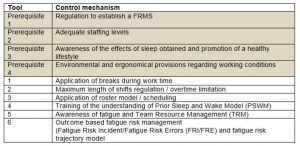53RD ANNUAL CONFERENCE, Gran Canaria, Spain, 5-9 May 2014WP No. 153Elements of FRMS ModelPresented by PLC |
Introduction
Objectives of this paper
One of the recommendations from the FRMS Working Paper presented at the IFATCA Annual Conference in Bali in 2013 was:
| ‘…specifics of the FRMS elements model should be further studied by IFATCA and presented as a working paper at conference 2014. As part of this study, existing IFATCA policy on fatigue should be reviewed.’ |
The FRMS Elements Model

Discussion
2.1 Development of this paper
2.1.1 After developing the various elements of the FRMS Model and comparing them to current IFATCA Policy, a draft working paper presenting these findings was discussed at length at the PLC meeting in February. It was at this meeting that PLC decided the Working Paper should be re-written explaining the reservations in proposing policy changes and the other contributing factors involved.
2.1.2 The work gone into the draft working paper was not to be discarded but to be kept to assist in the development of future work.
2.1.3 Part of this decision was also based on the fact that there are further developments ongoing with ICAO with regard to Fatigue Risk Management Systems. ICAO established a FRMS Task Force (FRMSTF) mandated to establish SARPs for FRMS within ATC. This is in the development phase and PLC expects to see some documentation from ICAO later this year (scheduled for release after the Annual Conference in Las Palmas). Whilst PLC sees that these SARPS will be high level and non-prescriptive, it was felt by the Committee this development was to form part of the review of IFATCA Policy.
2.2 ICAO Taskforce
2.2.1 The Task Force is assisting the secretariat in addressing (developing) FRMS regulations for ATC and convened in June 2013. The Task Force met in Montreal and has been developing SARPs and an FRMS Annex for the full ANCs review. Jeff Richards from NATCA is on the ICAO Task Force representing IFATCA’s interests. There are 22 members on the ICAO FRMS Task Force, as well as 6 scientists.
2.2.2 The IFATCA FRMS Rep (Mr Richards) also has corresponding members from M.A.s to assist him as SMEs (Subject Matter Experts) in his Task Force role. These people are being consulted with throughout this phase. The work the Task Force have been doing has taken longer than anticipated and had the guidelines (SARP’s) been released earlier, this paper could have progressed further.
2.2.3 PLC sees the FRMS Elements Model and the FRMS paper from Bali 2013 to be complimentary to this work the ICAO Taskforce are doing. Consulation between the two parties is recommended prior to making any amendments to IFATCA policy.
2.3 Current IFATCA Policy
2.3.1 When reviewing the IFATCA Technical and Professional Manual 2013 many areas were considered to be ‘out-of-date’ and perhaps no longer relevant, however without the background knowledge to their inclusion in policy and the fact that there was not enough information from relevant FRMS studies to amend or delete current policy, it was decided by PLC that further work has to be carried out. This work should include, but is not limited to;
- Gathering the background information to establish why we have prescriptive limits to hours of work in current policy.
- Current policy is prescriptive in nature and consideration ought to be taken whether this is appropriate to maintain, or that a high level approach without describing limits is better.
- Utilising the work done to date to further develop the FRMS Elements Model and IFATCA Policy.
2.3.2 An example of how one aspect of IFATCA Policy has become irrelevant/ out-of-date based on current studies is described below, however there are many more similar to this;
2.3.2.1 A FRMS study completed in 2001 referenced in last years’ conference paper found that “Midnight shifts should not exceed 8 hours and that a recuperative break of up to 2.5 hours is advised during this shift” (The Tripartite Steering Committee FRMS study 2001).
2.3.2.2 This study does not consider the effect known as ‘sleep inertia’ and cannot be discarded however this study creates the possibility that current IFATCA policy (WC 8.3.2) could no longer be relevant as it implies a shift can be longer than the current limit of 5 hours. The policy states “By night the total operational duty time should not exceed 5 hours”. In practise, there are many M.A.’s who work longer than 5 hours during a night/midnight shift.
Conclusions
3.1 FRMS in ATC has many different factors and only some relate to working conditions.
3.2 All factors need to be considered when establishing a FRMS. PLC need to wait until the outcomes/findings are known from the ICAO FRMS Taskforce before completing any further work. Members of this taskforce along with SME need to be consulted during the next phase and the IFATCA Policy review.
3.3 It is recommended that FRMS form part of the work program for PLC for 2014-2015.
Recommendations
4.1 It is recommended that this paper is accepted as information


